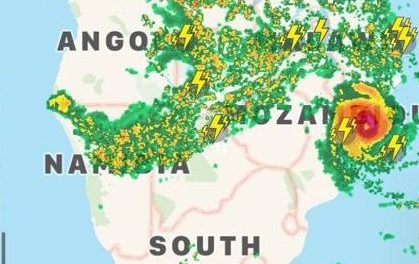
The Week’s Weather 02 December 2016
Heatwave conditions have set in again over the southern half of the country. This is readily seen in charts of the 500 mB surface where it shows very stable conditions. At that level, for most of this week, both vertical and lateral movement were subdued.
When the movement of air at the mid-level is restricted, it indicates a thickening of the atmosphere. In this period before the summer solstice, a so-called heat-low develops everyday over the southern African interior. This area of lower pressure draws in air from the surrounding atmosphere, where the barometric pressure is higher. This pressure differential is an extremely delicate mechanism, often reacting to pressure differences as small as 4 mB. That is four one thousandths of a bar so it should give an idea of how slight these pressure differences are. But weather systems are extremely large covering hundreds, sometimes a few thousand kilometres on the surface. Thus, despite the slight pressure differential the effect is enormous as was the case this week in the south.
Solar irradiation heats the atmosphere during the day and the air expands. This must go either sideways or up. When conditions are very stable at 18,000 feet with almost no windshear, the air column slowly rises. The 500 mB surface lifts and the atmosphere becomes thicker in the low pressure area. The effect is an air column covering hundreds of square kilometres, very slowly rising, drawing in more air all the time from the surrounding atmosphere. The moment the sun passes its daily zenith, the energy in the system very slowly starts to recede and the air column tends to descend. This leads to diabatic compression releasing energy and we experience it on the surface as excessive heat, or a so-called heat wave.
The massive impact of the heat wave is evident in another phenomenon, the anti-clockwise continental rotation that is the summer hallmark of the southern African subcontinent. Normally, where a low pressure system is present, its rotation in the southern hemisphere will be clockwise. Not so with the heat-low for the very simple reason that it is a descending column of air despite being inside a low pressure area.
This week, very large areas of the southern African subcontinent were subjected to this mechanism, with only weak lateral movement in the mid-levels over southern Angola, central Botswana and into the northern half of South Africa. By Friday, heat wave conditions covered almost the entire Namibia, Botswana, Zimbabwe and South Africa. The result was very hot days, the absence of precipitation and almost no surface wind. The only exception was the north-western corner of Namibia, the Kaokoveld where unstable conditions drew in moisture from southern Angola.
What to Expect
As the weekend begins, the South Atlantic high pressure cell of moderate strength, 1020 mB, lies some 1500 km west of Oranjemund. In the Indian Ocean, the southern Indian high has collapsed leaving only a very weak 1016 mB remnant south of Madagascar.
The heat-low over the sub-continent’s interior remains intense but restricted to central Botswana. The continental anti-cyclonic circulation advects moisture from central Angola southward entering Namibian airspace between Ruancana and the Kunene river mouth. Although a proper trough is not forecast to develop until next week Wednesday, the active conveyor system brings clouds to the Namibian interior on a daily basis from Saturday to next week Tuesday.
However, the approaching South Atlantic high opposes the intrusion from the north on the surface and conditions are not ideal for precipitation. A convergence zone develops where the two systems meet, running as is typical from the Kunene through the middle of Namibia, to the Karasburg district.
From Monday onwards, a more prominent low pressure system develops along the coastlines of Angola and Namibia, moving southward, and bringing in more moisture but rainfall is restricted to Namibia’s northern half and central Botswana. By Wednesday a weak mid-level trough develops from Angola through Namibia and Botswana into South Africa. Rainfall prospects improve but only east of the convergence line running from Ruacana south-eastward through Windhoek to Mata Mata.









































